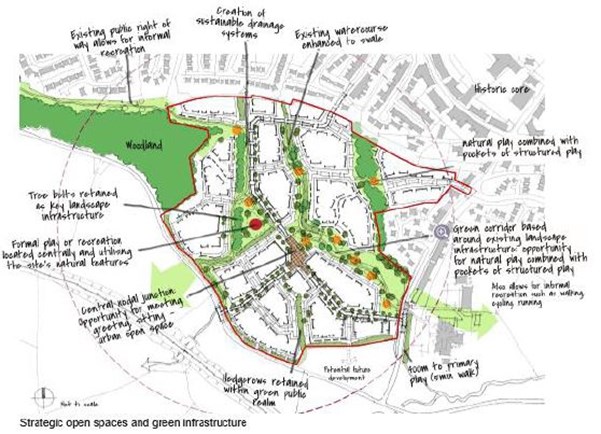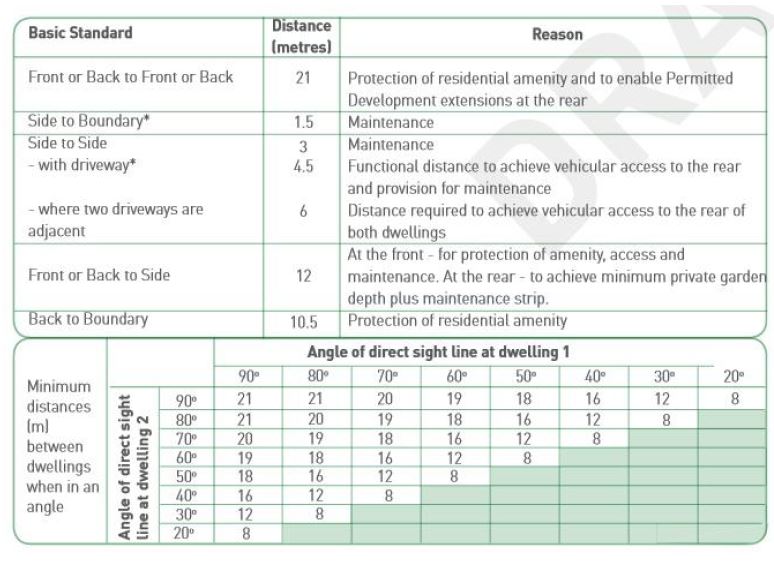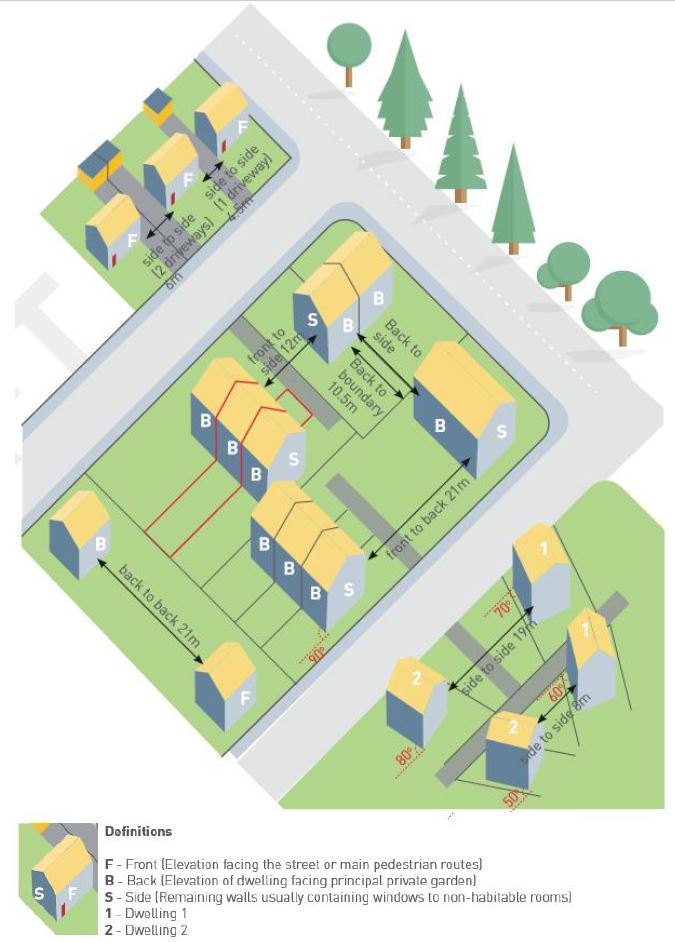The layout of a development refers to the way in which buildings, routes and open spaces are placed in relation to each other. It provides the two-dimensional structure on which all other aspects of the development depend. To this end, the layout is one of the most critical factors in determining the impact and success of development.
Key to the success of any layout will be the way it responds to its surroundings. Often layouts which involve regimented geometric arraignments of repetitive house types result in bland and rather sterile results which bore little relation to their locality. In rural North Norfolk, more informal groupings of houses tend to be more compatible with variation in sitting, orientation and house types. Creating enclosure to the street will help to realise the sense of unveiling as you move through a development.
A good layout should be well connected and offer a clear hierarchy of movement and permeability. Layouts which rely on a single distributer road or a cul-de-sac make it difficult to understand and move around effectively other than by car. Although quiet pockets such as set-back crescents of homes can be successful, dead ends are just that, dead in their perception and feel. Having too many dead ends in a residential area can stifle community cohesion by making it less likely that people will walk, cycle, meet people and feel part of their community.
Effective layouts avoid small leftover areas of unloved and unused space between homes or public realm. This can be a common problem with housing development if the layout is designed primarily to accommodate standard building types, required building separation distances and car parking requirements, rather than to create a well-structure neighbourhood.
The way buildings are grouped and re late to each other is one of the most powerful influences on how we react to the built environment. Whether they are arranged formally or informally, in a courtyard or linearly either side of a road, the manner in which they are laid out creates identifiable spaces each with their own character. It is often the way these spaces are sequenced and layered which provides the interest, variety and reveals the next space.
The layout of the development must also consider the optimum orientation of each unit. Where possible buildings should be orientated to make maximum use of passive solar gain and thus reduce space heating requirements.
When designing a network of paths and streets, it is vital to remember that these are some of the most permanent features of the built environment. By avoiding cul-de-sac’s and limited movement networks greater choice and variety will be secured and traffic will be dispersed. It is vital to think about how different users will experience the site as they travel through. Blank facades and elevations within the public realm do not provide an attractive experience and offer little enjoyment to users.
Key Considerations
If the following points can be addressed then the layout of the scheme will be greatly improved:
- Creation of a network of streets and spaces that connect with each other and offer choice of routes for all users and modes of transport.
- A clear and logical order of streets and spaces resulting in a ‘street hierarchy’. The range of street types integrating differing features often with differing widths, frontages, parking arrangements with a range of differing uses, landscaping and materials.
- Streets where buildings and landscaping dominate the highway and hard surfacing.
- Provision of links to neighbouring land and wider network of routes, facilities and recreational opportunities.
- Connections to existing streets, paths and creation of new links avoiding dead zones and cul-de-sacs.
- Provision of local services and facilities on site but if not viable then clos e links to these provisions off-site. Local facilities should be within walking distance of all new homes (5-10 mins) and provides easy access for existing and new residents.
- Provides key public transport links within 5min walk of homes. A primary school should be within 600m and 1500m for a secondary school.
- Layout should create a pleasant and enjoyable environment for all users travelling through and using the site.
- A safe and well managed environment should provide adequate access for wheelchairs, pushchairs e.g. dropped kerbs etc.


Space About Dwellings
Taking those basic criteria a step further, the table and diagram below show how the amenity criteria could work in practice. It should be noted that where it can be clearly demonstrated that strict observance of these criteria would be harmful to design quality, or to the form and character of an area, reductions in these guide distances, may be permissible. Without such flexibility, layouts may become uniform and lacking in visual interest and local distinctiveness. They may also fail to make the most efficient use of land and therefore not achieve the necessary densities set out within the corresponding site allocation.

Siting, alignment & distances table

Siting, alignment & distances plan
Efficiency
At a time when facing up to climate change should be a priority, the efficient use of resources which includes space, energy, materials and water must be an essential element of design quality. Any well designed place should be inherently efficient and sustainable, it should not waste land, water, energy or create unnecessary requirements for people to travel.
Land is a scarce re source and should be treated as such. Good design is efficient in the social, environmental and economic aspects of sustainable development. Wasteful, poorly designed proposals that take a short-term view can result in visually uninspired, functionally weak and often maintenance-hungry developments. Such ill-conceived layouts will not be land efficient and often result in lower end value.
The arrangement of house types along a street should achieve efficiency of land and avoid left over spaces. The grouping of similar typologies can provide greater land efficiency and the kit of parts including (front boundary, gardens, parking, storage, landscaping etc). can be arranged more effectively. Leftover space that is awkward to maintain, small and compromised must be designed out. Housing which fronts attractive open space is often the most desirable. The more attractive the open space is, the greater the potential place value. Resources should be used efficiently in the construction and operation of buildings and places. This should be considered in relation to orientation, drainage, energy, movement, waste and greenspace.
